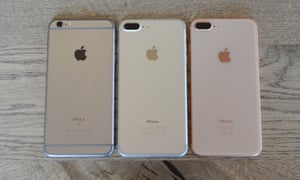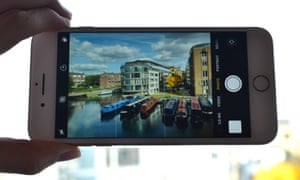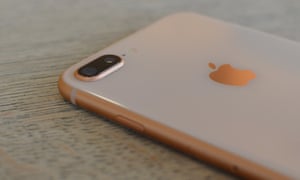iPhone 8 Plus review: still massive – but not in a good way
he iPhone 8 Plus might have some fancy camera tricks up its sleeve, but is it really worth buying its bulky frame ahead of its sleeker rivals or the potential of the iPhone X?
Like its smaller non-Plus sibling, the design of the iPhone 8 Plus has barely changed since it was introduced in 2014 with the iPhone 6 Plus, but it has aged worse. The iPhone 6 Plus was thin but relatively wide and tall for a smartphone with a 5.5in screen in 2014, with big bezels and a chunky top and bottom.
Dated design
Four years on the design of the iPhone 8 Plus makes it look incredibly dated, like a cheap iPhone knock off. It’s a feeling that’s accentuated by the new pinky gold colour, which reminds me of my grandma’s hideous bathroom suite – the kind you have to replace just to sell a house. At least it comes in black and silver too.
The iPhone 8 Plus is fractions of a millimetre larger in every direction than the iPhone 7 Plus. It’s 14g heavier than the iPhone 7 Plus, 10g heavier than the iPhone 6S Plus and 30g heavier than the iPhone 6 Plus. At a total weight of 202g the iPhone 8 Plus feels pretty heavy, with only the Samsung Galaxy Note 8 with its colossal 6.3in screen coming anywhere near at 195g. Most rivals weigh around 160g.
The biggest issue is the iPhone 8 Plus is very wide and rounded for a device with what is a relatively small screen. At 78.1mm wide, it’s a whole 10mm wider than the Samsung Galaxy S8 with a 5.8in screen and it’s even 3.3mm wider than the giant Note 8.
The wider a phone, the harder it is to hold with one hand. No matter how much you might consider the 8 Plus a two-hand device, at some point you will have to use it with one hand and that’s when people tend to drop their smartphones.
The big change for the iPhone 8 Plus is that its back is made of glass, which inevitably makes it more fragile. Despite the glass being more grippy in the hand, and more slippy on the arm of a sofa, most will put it in a case – at which point it’s very difficult to tell that it’s a brand new model.
The 5.5in screen is probably the best-looking LCD I’ve seen and now has Apple’s True Tone system from the iPad that alters the colours of the display based on the ambient light.
Specifications
- Screen: 5.5in LCD 1920x1080 (401ppi)
- Processor: Apple A11 Bionic
- RAM: 3GB of RAM
- Storage: 64/256GB
- Operating system: iOS 11
- Camera: Dual 12MP rear cameras, 7MP front-facing camera
- Connectivity: LTE, Wi-Fiac, NFC, Bluetooth 5, Lightning and GPS
- Dimensions: 158.4 x 78.1 x 7.5mm
- Weight: 202g
Long lasting and wireless charging
The iPhone 8 Plus has the same six-core A11 Bionic processor as its smaller sibling, but has an extra gigabyte of memory to help with multitasking. It performed similarly to the iPhone 8 and the iPhone 7 Plus before it in day-to-day activities.
Battery life is solid, lasting over 32 hours between charges on average – a increase of 5 hours on the iPhone 7 Plus – meaning that you’ll be able to make it to lunch time the next day if you forget to charge it overnight. That’s with hundreds of push notifications, 10 or so photos, a 90-minute burst of Netflix, a couple of short phone calls, a quick game and about 7 hours of listening to Spotify over Bluetooth earbuds.
With that level of stamina the iPhone 8 Plus has few rivals. Samsung’s longest-lasting smartphone in my testing has been the Galaxy Note 8, lasting just over 31 hours between charges. Under lighter use cases I suspect many will manage two days between charges, but it’s worth noting that might not be the case in two years as the battery starts to lose capacity.
The Plus variants of the iPhone have always charged faster than the smaller non-Plus versions, if connected to the right charger. Now both fast charge from USB-C Power Delivery chargers such as those that come with the Google Pixel or USB-C charged laptops and tablets. Unfortunately neither the required USB-C to Lightning cable nor a fast charger comes in the box.
The glass back enables wireless charging, which is great for charging at your desk or at night on a bedside table. Just put the phone on the right spot and it starts to charge. It’s slower than via cable, and although it will get faster with an update later this year it still won’t match a USB-C charger.
iOS 11
Not a vast amount has changed within iOS 11 compared to last year’s iOS 10, and most of the meaningful things are confined to the iPad. For more please see the iPhone 8 review.
Camera
The iPhone 8 Plus has two improved 12-megapixel cameras on the back, which both have physically larger sensors than last year’s iPhone 7 Plus on which Apple’s dual-camera system was introduced. The two cameras work together: one has a standard wide-angle f/1.8 lens (the same as fitted to the iPhone 8), the other has a slower f/2.8 lens with an effective two-times magnification compared to the standard lens.
It also enables some fancy camera effects Apple calls Portrait Mode and Portrait Lighting, which uses depth information and facial mapping to artificially blur the background of a photo or apply different lighting effects to a person’s face.
While the technology has been refined since last year, I still get weird aberrations in about half of photos using the software trickery, with the system struggling to discern what should and shouldn’t be blurred. I find I can get better results simply by framing my subjects better and physically moving like you have to with a prime lens on a dSLR.
The Portrait Lighting effects are more fun, although not once did the subject think they looked better with the “contour light” option enabled, as it accentuated flaws and gave some the impression of having been awake for 48 hours.
Software tricks aside, the wide-angle camera is just as good as that fitted to the iPhone 8, and I got noticeably better results with telephoto camera compared to the iPhone 7 Plus. The iPhone 8 Plus, like the iPhone 8, easily has one of the best cameras on the market.
The 7-megapixel selfie camera is great too, although some might not like the level of detail it preserves – if you have big pores, as I do, be prepared for them to show up. You can always soften these kinds of details after the fact.
Observations
- The iPhone 8 Plus is water resistant, and doesn’t have a headphone jack
- The glass back is a fingerprint magnet
- 1080p 240fps slow-motion videos are fun
- The large camera lump on the back makes the phone rock around when used on a desk
Price
The iPhone 8 Plus costs £799 with 64GB of storage or £949 with 256GB of storage, and comes in three colours: silver, gold and black (“space grey”).
For comparison, that’s £80 more for the cheapest version of the iPhone 8 than last year’s iPhone 7 (but the iPhone 8 Plus comes with twice the storage) and £100 more than the iPhone 8. The Samsung Galaxy S8 with 64GB of storage is under £540, the S8 Plus with 64GB of storage is under £630 and the Note 8 with 64GB of storage costs under £830. The 5.5in OnePlus 5 with 64GB of storage costs £449. Google’s £719 Pixelis about to be replaced.
Verdict
The iPhone 8 Plus is a big, chunky phablet that stands out like a sore thumb in the crowded marketplace filled with sleeker rivals. It’s massive, and not in a good way, in an era where a big screen doesn’t have to mean a big phone. That design was ok in 2014, not too bad by 2015, bad by 2016 and downright rubbish in 2017.
It’s a shame. The innards of the phone, the camera on the back and the battery life are great. More so than the iPhone 8, which is smaller and slightly cheaper and so has a place in an iPhone-only world, the iPhone 8 Plus is cripplingly overshadowed by the iPhone X, which will have everything the Plus has (apart from a fingerprint scanner) plus a much improved design.
If it was cheap, that’d be fine, but it’s not. £800 is a lot to spend on a compromised phone. If you’re an iPhone-only buyer, for once my recommendation is fairly straightforward: don’t buy the iPhone 8 Plus, at the very least until you’ve seen what the iPhone X is capable of in November.
Pros: 32-hour battery life, great dual-camera system, water resistant, wireless charging, fingerprint scannerCons: bad 2014 design, no headphone jack, no fast charger in the box, expensive, massive bezels, too wide to comfortably hold, heavy




Comments
Post a Comment